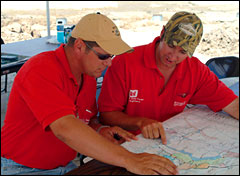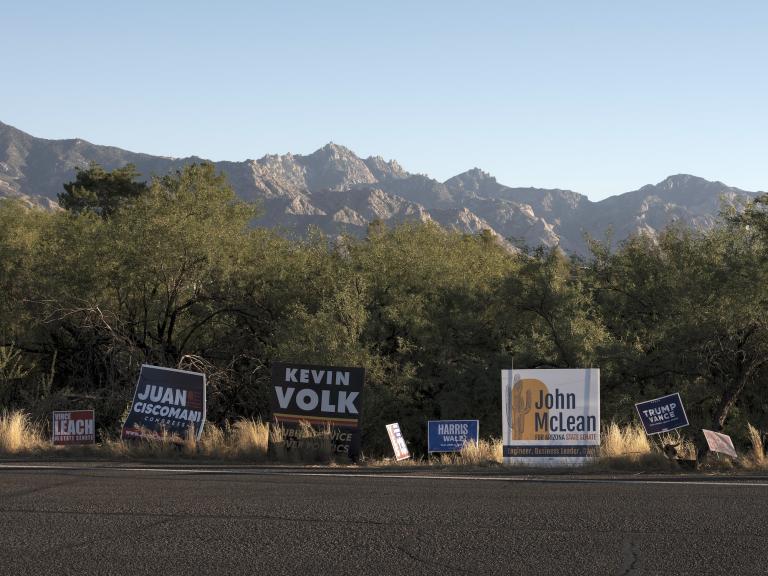
Here’s the good news: The Army Corps of Engineers is “racing” to complete a comprehensive levee system for metropolitan New Orleans by 2011 that actually takes into account global warming, at least in terms of sea-level rise.
Here’s the bad news: the levee system under development is wildly insufficient to the growing climate problem, according to many informed critics.
That’s because the vast and flat Louisiana coastal area — sometimes called the “Bangladesh of America” because it could disappear due to sea-level rise alone — cannot be saved just by building levees. It’s the one area of America which, to survive the rising water and bigger hurricanes of a warming world, must develop human-made barrier islands and coastal marshes as an additional emergency defense. These landforms, which can be crafted using the voluminous sediments of the Mississippi River itself, would create a vital buffer that complements the levees, according to a wide range of engineers.
“It all comes down to this: You simply can’t build the levees high enough under any scenario in Louisiana,” said Clifford Smith, a member of the prestigious Mississippi River Commission, a seven-member panel created by Congress to advise the corps on works projects. “That the corps still doesn’t act on this fact, doesn’t commit to building wetlands and barrier islands immediately, leaves me so depressed you can’t imagine it. I’m in depression over this.”
Ironically, many Americans still point to Hurricane Katrina as the event that finally got their attention on global warming. It’s impossible to definitively prove or disprove the connection of any single weather event to global warming. But it was Katrina and the record hurricane season of 2005 that left many folks wondering what was up with the weather. Nearly three years later, global warming practically dominates the daily news in dozens of different ways. Author Bill McKibben describes the change in our national awareness this way: “Katrina opened the door and Al Gore walked through it.”

Oliver Houck.
Photo: tulane.edu
But even after a Nobel Prize last fall for Gore, who shared it with the world’s leading climate scientists, and even after new studies showing hurricanes are getting bigger and more frequent due to warming oceans, the Army Corps can’t seem to commit to a protection plan that matches the global climate reality as it pertains to New Orleans.
“The number one thing protecting New Orleans right now is not the corps, it’s chance,” says Tulane University law professor and coastal protection activist Oliver Houck. “The historical odds show Katrina doesn’t come every day. That’s all that’s really protecting us right now. The odds.”
A Closer Look at Task Force Hope
To the corps’ credit, its massive “Task Force Hope” levee construction project, costing nearly $15 billion and slated for completion by 2011, will anticipate sea-level rise from global warming roughly equal to what has already been observed in recent decades. The plan also anticipates the natural sinking of the fragile Louisiana coast. Both factors affect how high a hurricane surge tide will be as it moves onto land. The levees, in theory, will also be built wide enough to allow engineers to add at least marginally to their height later on, creating so-called “lifts,” according to several spokespeople at the corps.

Dr. Lewis “Ed” Link.
Photo: usace.army.mil
“We know we have warming, and the corps is taking that in as a factor,” says Dr. Lewis “Ed” Link, former director of Research and Development at the corps and a chief contributor to the risk assessment modeling underlying the planned levee improvements. “Different [levee] segments will have different improvements based on land contours, but the range is 12 to 15 percent higher levees being planned for.”
The problem, according to a growing number of concerned observers, is that past warming rates and impacts are almost certainly no indication of the future now that NASA satellite imagery shows a rapidly deteriorating Greenland ice sheet.
How high will sea level go? Two feet by 2100? Ten feet? How big will hurricanes get? How frequently will they come? It’s uncertain, of course, but the observed trends and scientific forecasts keep getting worse. And if there’s one region of America that should plan for something akin to “the worst,” it’s the flat alluvial region of south Louisiana, home to one-third of America’s domestic seafood catch, lots and lots of oil and gas infrastructure, and the critically important port of New Orleans.
Both the deepening risks of climate change as well as the range of possible impacts argue for the abandonment of a de facto “levees only” approach, say Houck and others. What’s needed with an urgency and commitment equal to the levee plan is a program to build “nature’s levees,” also known as barrier islands and coastal marshes. These landforms have historically served to greatly lessen the impacts of past hurricanes on New Orleans and the rest of the Louisiana coast. But it’s the Army Corps’ efforts to control Mississippi River flooding over the past century and a half that have caused these very land forms to erode and vanish.

Corps employees scope out damage caused by Hurricane Rita, a month after Katrina.
Photo: usace.army.mil
More than a million acres of land has turned to water in coastal Louisiana just since World War II. And if the coast has any hope of surviving the next Katrina (whose astonishing surge tide was up to 30 feet as she hit land in Louisiana), then much of this protective coastal terrain must be rebuilt — literally turning water back to land — and at a rate that outpaces sea-level rise and the expected growth in storm intensity.
Here’s where the planning truly breaks down within the Army Corps process, according to Smith and others. Ambitious initiatives to build new barrier islands and wetlands were expected to emerge from the Louisiana Coastal Protection and Restoration bill passed by Congress in 2006. It called on the corps to present a comprehensive protection plan for coastal Louisiana — i.e., more than just levees — by December 2007. The corps missed the deadline, but now expects to deliver the plan this fall.
Unfortunately, no one privy to deliberations within the corps believes an adequate commitment to rapid land building will be forthcoming, no matter how clear the need.
“The problem is it’s not in the corps’ nature to ask Congress for new problems to solve,” said Mark Davis, recent past director of the Coalition to Restore Coastal Louisiana. “This is an organization that historically has been a levee-building organization. That’s what it knows how to do. Using levees alone now is like asking a Revolutionary War soldier to fight in Iraq. You don’t have the right weapons.”
Building a Legacy
The missing weapon, according to Davis and others, is the Mississippi River itself. Carefully diverting part of the river’s muddy water away from the main stem and toward rapidly eroding coastal areas would allow sediments to build up and create land in the ancient delta-forming fashion. Special pipelines and canals could be used to surgically deliver the sediment-rich water to exactly the spots where land is needed most to protect against hurricane surges made worse by sea-level rise. With sufficient planning and funding — at least $28 billion — and a willingness to relocate at least some of the coastal population, there’s little doubt among engineers and coastal geologists that the process will succeed in making land.
“We could build entire barrier islands in 12 months or less,” says Davis, who now directs Tulane’s Institute on Water Resources Law and Policy.
There’s just no sign so far that the corps is ready to commit to the process. Without it, however, most serious observers view New Orleans as flat-out doomed.
The ultimate problem, according to Davis, is that the corps takes its orders directly from Congress, a body that has only recently begun to discuss climate change seriously, much less act on it. Congress has told the corps to build bigger and better levees as a result of Katrina, and it’s obeying. But there have been no direct orders pertaining to global warming. Indeed, just last May, a Senate bill that would require the corps to consider the impact of climate change in designing all its water resources projects nationwide fell nine votes short of the 60 needed to beat a filibuster. In that context, the corps’ decision to plan for even modest future sea-level rise in New Orleans might seem a minor miracle.
Will a new U.S. president and larger Democratic majorities in Congress change the nation’s approach to saving coastal Louisiana? Maybe. But what’s really needed is a realization among a majority of American voters that life without New Orleans will be one of the biggest and most painful — and perhaps earliest — casualties of global warming.
And if we can’t save New Orleans, is there really any hope for Miami, Charleston, New York, Annapolis, and all the other low-lying coastal cities in the queue?


